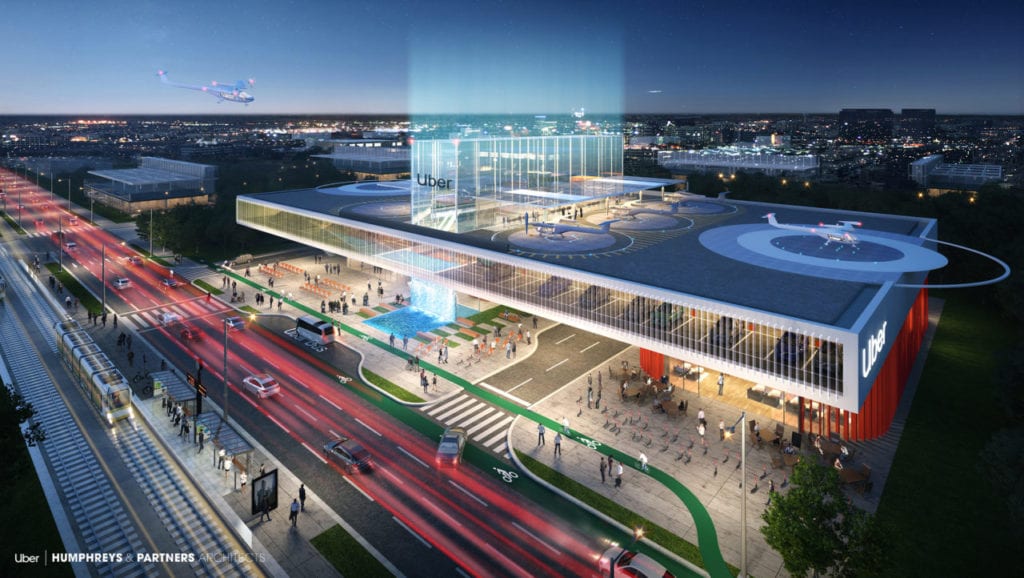
An Uber Skyport design presented by Humphreys and Partners showcases what urban air mobility could look like if properly integrated into city landscapes. (Photo: Uber)
As the fundamental technologies behind the emerging urban air mobility market continue apace, a nonprofit industry association called the Community Air Mobility Initiative (CAMI) has entered the scene to tackle challenges related to public acceptance and transit integration.
CAMI, run by co-executive directors Anna Dietrich and Yolanka Wulff, aims to conduct education, outreach and advocacy to “support the responsible integration of urban air mobility into communities,” according to the organization.
In a kickoff call with invited members of the UAM industry, Wulff explained some of the challenges facing successful UAM adoption that CAMI will focus on.
“Today’s aviation industry operates separately from other forms of urban transportation,” Wulff said. “When we talk about the vision that we have for urban air mobility, we’re asking aviation to intimately integrate into an existing urban transportation system. And in fact, that is what makes urban air mobility both so valuable and interesting, but also challenging.
“Urban transportation, as most of us know, has its own challenges already: congestion, sprawl, environmental impacts and noise,” Wulff continued. “So, what we are looking to do with urban air mobility is create a third dimension too that transportation system, but fully integrated with it, not separate as aviation has been to date. And that presents all kinds of challenges and issues.”
Those challenges include laws related to zoning, private property and noise restrictions, all of which are more complicated inside a city than on its outskirts where airports are typically located. Curbside management, for example — keeping traffic moving while allowing buses and rideshare vehicles to load and unload — will be a key challenge associated with vertiports located in urban areas.

The Community Air Mobility Initiative seeks to work on the local public acceptance and integration challenges associated with the emerging urban air mobility market. (CAMI)
“As we thought about CAMI and the role it could serve, we realized that there was a need to bridge the aviation industry and the move towards developing these aircraft and the standards and regulations that would allow those to be certified … and the local communities, urban areas and regions where these aircraft would fly to ensure that there was a market and a community that understood the value of this new technology and embraced it as part of their future urban transportation system,” Wulff said.
In New York City, where Uber recently opened downtown-to-airport helicopter service via Uber Copter, a journalist race by NYPost suggests the $200 ticket price may actually take longer than public transit, depending on one’s starting point. The reporter travelling by air had to take two separate Uber cars to reach the helipad near South Street Seaport. Other helicopter rideshares, including Airbus’ Voom, are facing similar challenges to the time-centric value proposition of the service, according to conversations with industry experts.
Uber recently rolled out public transit integration within its app in cities including NYC and Washington, D.C., offering directions via train and bus similar to Google Maps. Rideshare competitor Lyft has done the same. Uber’s IPO filing earlier this year styled itself as “the Amazon of transportation,” and the company’s visions for Skyport hubs, presented at Uber Elevate this summer, seek to orchestrate “a seamless transition between ground transit like Uber Pool and eVTOL aircraft on the roof tarmac,” according to John Badalamenti, Uber’s head of design for Elevate.
 | Don’t miss a beat on urban air mobility and eVTOL aircraft development. Sign up for our brand new e-letter, “The Skyport,” sent to inboxes every other Thursday with all the latest news, analysis and insider scoops. |
No transition involving UAM will be seamless unless the public, city governments and the many other stakeholders involved — including rich and influential property owners — are in favor and engaged early on. Many city planners and economic development officials reached for discussion about UAM had never heard of the term, according to one industry consultant who has initiated such conversations.
“This is a fairly time-sensitive project that we’ve undertaken,” Dietrich said. “We do need to get ahead of potential issues with awareness and education now, while the policies are first being considered. After we already have legislation and policy and zoning requirements on the books restricting this kind of activity, it will be much harder to recover from that and change that, as opposed to working with these decision-makers from the beginning.”
CAMI announced the following companies and organizations as its founding members:
- Bell
- Black and Veatch
- Choctaw Nation of Oklahoma
- General Aviation Manufacturers Association (GAMA)
- Joby Aviation
- Jump Aero
- Karem Aircraft
- Massachusetts Department of Transportation
- National Business Aviation Association (NBAA)
- Raytheon
- SAE International
- Unmanned Safety Institute
- Vertical Flight Society